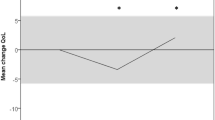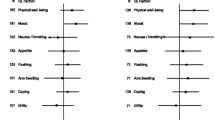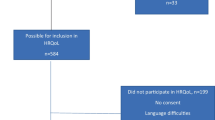Abstract
In 186 patients with early colon cancer, we investigated the assumption that the meaning of ‘quality of life’(QL) remains constant over time. Within a phase-III trial (SAKK 40/93), patients estimated both their overall QL and a range of disease- and treatment-related domains at five timepoints, comprising three concurrent and 2 retrospective estimates: their pre-surgery QL both before surgery and retrospectively thereafter, and their pre-adjuvant QL both at the beginning of adjuvant treatment and retrospectively about 2 months later, and their current QL 2 weeks thereafter. Multilevel models were developed to determine whether the selected domains made stable contributions to overall QL at the concurrent estimates. The weights of the domains changed over time. They did not differ significantly according to whether patients were considering their concurrent state or reflecting on this state at a later timepoint. In the process of adaptation, patients with early colon cancer substantially change the relative importance of QL domains to overall QL. This finding argues for QL as a changing construct and against the assumption that domain-specific weights are stable across distinct clinical phases.
Similar content being viewed by others
References
McGee HM, O'Boyle CA, Hickey A, O'Malley K, Joyce CRB. Assessing the quality of life of the individual: The SEIQoL with a healthy and a gastroenterology unit population. Psychol Med 1991; 21: 749–759.
Hickey AM, Bury G, O'Boyle CA, Bradley F, O'Kelly FD, Shannon W. A new short form individual quality of life measure (SEIQoL-DW): Application in a cohort of individuals with HIV/AIDS. Brit Med J 1996; 313: 29–33.
Ferrans CE, Powers MJ. Quality of life index: Development and psychometric properties. ANS Adv Nurs Sci 1985; 8: 15–24.
Tugwell P, Bombardier C, Buchanan WW, Goldsmith CH, Grace E, Hanna B. The MACTAR Patient Preference Disability Questionnaire-an individualized functional priority approach for assessing improvement in physical disability in clinical trials in rheumatoid arthritis. J Rheumatol 1987; 14: 446–451.
Cella DF, Tulsky DS, Gray G, et al. The functional assessment of cancer therapy scale: Development and validation of the general measure. J Clin Oncol 1993; 11: 570–579.
Becker M, Diamond R, Sainfort F. A new patient focused index for measuring quality of life in persons with severe and persistent mental illness. Qual Life Res 1993; 2: 239–251.
Henrich G, Herschbach P. Questions on Life Satisfaction (FLZM)-A short questionnaire for assessing subjective quality of life. Eur J Psychol Assessment 2000; 16: 150–159.
Wright JG, Young NL. The patient-specific index: Asking patients what they want. J Bone Joint Surg Am 1997; 79: 974–983.
Mozes B, Shabtai E. The contribution of personal rating to the clinimetric functioning of a generic quality of life instrument. J Clin Epidemiol 1996; 49: 1419–1422.
Larsson G, Sjoden PO, Oberg K, von Essen L. Importancesatisfaction discrepancies are associated with health-related quality of life in five-year survivors of endocrine gastrointestinal tumours. Ann Oncol 1999; 10: 1321–1327.
Tishelman C, Degner LF, Mueller B. Measuring symptom distress in patients with lung cancer. A pilot study of experienced intensity and importance of symptoms. Cancer Nurs 2000; 23: 82–90.
Trauer T, Mackinnon A. Why are we weighting? Qual Life Res 2001; 10: 579–585.
Osman LM, McKenzie L, Cairns J, et al. Patient weighting of importance of asthma symptoms. Thorax 2001; 56: 138–142.
Neudert C, Wasner M, Borasio GD. Patients' assessment of quality of life instruments: A randomised study of SIP, SF-36 and SEIQoL-DW in patients with amyotrophic lateral sclerosis. J Neurol Sci 2001; 191: 103–109.
Sprangers MA, Schwartz CE. The challenge of response shift for quality-of-life-based clinical oncology research (editorial). Ann Oncol 1999; 10: 747–749.
Sprangers MAG, Schwartz CE. Integrating response shift into health-related quality of life research: A theoretical model. Soc Sci Med 1999; 48: 1507–1515.
Bernhard J, Hurny C, Maibach R, Herrmann R, Laffer U.Quality of life as subjective experience: Reframing of perception in patients with colon cancer undergoing radical resection with or without adjuvant chemotherapy. Swiss Group for Clinical Cancer Research (SAKK). Ann Oncol 1999; 10: 775–782.
Bernhard J, Lowy A, Maibach R, Huerny C. Response shift in the perception of health for utility evaluation. An explorative investigation. Eur J Cancer 2001; 37: 1729–1735.
Bernhard J, Sullivan M, Huerny C, Coates AS, Rudenstam CM. Clinical relevance of single item quality of life indicators in cancer clinical trials. Br J Cancer 2001; 84: 1156–1165.
Bernhard J, Maibach R, Thuerlimann B, Sessa C, Aapro MS. Patients' estimation of overall treatment burden: Why not ask the obvious? J Clin Oncol 2002; 20: 65–72.
Coates A, Fisher Dillenbeck CF, MCNeil DR, et al. On the receiving end II. Linear analogue self-assessment (LASA) in evaluation of aspects of the quality of life of cancer patients receiving chemotherapy. Eur J Cancer Clin Oncol 1983; 19: 1633–1637.
Coates A, Gebski V, Bishop JF, et al. Improving the quality of life during chemotherapy for advanced breast cancer. A comparison of intermittent and continuous treatment strategies. N Engl J Med 1987; 317: 1490–1495.
Butow P, Coates A, Dunn S, Bernhard J, Hürny C. On the receiving end IV: Validation of quality of life indicators. Ann Oncol 1991; 2: 597–603.
Hürny C, Bernhard J, Bacchi M, et al. The Perceived Adjustment to Chronic Illness Scale (PACIS): A global indicator of coping for operable breast cancer patients in clinical trials. Swiss Group for Clinical Cancer Research (SAKK) and the International Breast Cancer Study Group (IBCSG). Support Care Cancer 1993; 1: 200–208.
Hürny C, Bernhard J, Coates AS, et al. Impact of adjuvant therapy on quality of life in women with node-positive operable breast cancer. International Breast Cancer Study Group. Lancet 1996; 347: 1279–1284.
Hürny C, Bernhard J, Coates A, et al. Responsiveness of a single-item indicator versus a multi-item scale: Assessment of emotional well-being in an international adjuvant breast cancer trial. Med Care 1996; 34: 234–248.
Sloan JA, Loprinzi CL, Kuross SA, et al. Randomized comparison of four tools measuring overall quality of life in patients with advanced cancer. J Clin Oncol 1998; 16: 3662–3673.
Bernhard J, Thurlimann B, Schmitz SF, et al. Defining clinical benefit in postmenopausal patients with breast cancer under second-line endocrine treatment: Does quality of life matter? J Clin Oncol 1999; 17: 1672–1679.
Bernhard J, Hürny C. Gastrointestinal cancer. In: Holland J (ed.),Psycho-oncology, Oxford: Oxford University Press, 1998; 324–339.
Howard GS, Ralph KM, Gulanick NA, Maxwell SE, Nance SW, Gerber SK. Internal invalidity in pretest-posttest self-report evaluations and a re-evaluation of retrospective pretests. Appl Psychol Meas 1979; 3: 1–23.
Rasbash J, Browne W, Goldstein H. A user's guide to MLWIN. London: Centre for Multilevel Modelling, Institute of Education, University of London, 2000.
Goldstein H. Multilevel statistical models. London: Edward Arnold, 1995.
Lowy A, Bernhard J. Quantitative assessment of changes in patients' constructs of quality of life: an application of multilevel models. Qual Life Res 2004; 13: 1177–1185.
Rothman K. The assessment and control of confounding. Modern epidemiology. Boston: Little, Brown and Co, 1986; 125–126.
Wan GJ, Counte MA, Cella DF. The influence of personal expectations on cancer patients' reports of health-related quality of life. Psychooncology 1997; 6: 1–11.
Bromberg MB, Forshew DA. Comparison of instruments addressing quality of life in patients with ALS and their caregivers. Neurology 2002; 58: 320–322.
Little R, Rubin D. Statistical analysis with missing data. New York: Wiley, 1987.
de Haes JC, de Ruiter JH, Tempelaar R, Pennink BJ. The distinction between affect and cognition in the quality of life of cancer patients-sensitivity and stability. Qual Life Res 1992; 1: 315–322.
Jansen SJ, Stiggelbout AM, Nooij MA, Kievit J. The effect of individually assessed preference weights on the relationship between holistic utilities and nonpreference-based assessment. Qual Life Res 2000; 9: 541–557.
Bult JR, Hunink MG, Tsevat J, Weinstein MC. Heterogeneity in the relationship between the time tradeoff and Short Form-36 for HIV-infected and primary care patients. Med Care 1998; 36: 523–532.
Aaronson NK, Ahmedzai S, Bergman B, et al. The European Organization for Research and Treatment of Cancer QLQ-C30: A quality-of-life instrument for use in international clinical trials in oncology. J Natl Cancer Inst 1993; 85: 365–376.
Pehrsson K, Olofson J, Larsson S, Sullivan M. Quality of life of patients treated by home mechanical ventilation due to restrictive ventilatory disorders. Respir Med 1994; 88: 21–26.
Author information
Authors and Affiliations
Rights and permissions
About this article
Cite this article
Bernhard, J., Lowy, A., Mathys, N. et al. Health related quality of life: A changing construct?. Qual Life Res 13, 1187–1197 (2004). https://doi.org/10.1023/B:QURE.0000037485.59681.7d
Issue Date:
DOI: https://doi.org/10.1023/B:QURE.0000037485.59681.7d




